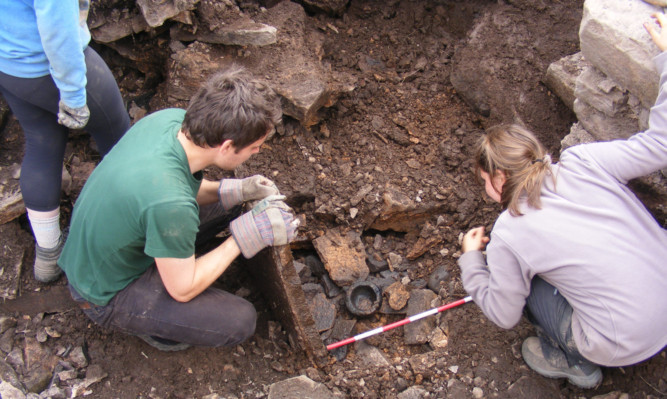The future of one of the most fascinating archaeological discoveries made in Perthshire for many years will be explored next month.
Castle Craig Fort and Broch will be the subject of two events during Perth and Kinross Heritage Trust’s Archaeology Month, which runs throughout June.
The site is hugely important as it offers a rare opportunity to follow the evolution of a Celtic stronghold from first habitation, through contact with the Romans, to the emergence of the Scottish kingdom.
Tentative exploration of Castle Craig a large rocky knoll on a lower spur of Craig Rossie, which dominates the skyline to the south of Auchterarder first took place in 1978.
At the time, it was thought to be the site of a prehistoric hill fort and initial investigations were carried out by archaeologist John Sherriff.
The tantalising evidence of occupation revealed by that work convinced the Strathearn Environs And Royal Forteviot (SERF) Project, run by Glasgow University, to explore the hill more closely.
And in August 2011, Dr Heather James led a team to discover a previously unknown stone-built broch lying beneath a metre of rubble including evidence of a later timber palisade.
The next surprise for the team was its massive scale, with the circular fortified dwelling measuring around 23 metres in diameter and with walls a staggering five metres thick.
They found evidence that the broch had been burnt and deliberately demolished, prior to the reuse of the site as a Pictish fortress.
Nonetheless, the ground floor survived relatively intact, with walls continuing to stand more than one and a half metres in height in some places around the summit of the hill.
Crucially, the abrupt destruction, covering-over of the site and subsequent construction of a fort sealed away a wide variety of artefacts, which have been preserved in stunning condition.
They, coupled with the structure’s construction, have offered a rare insight into those who once ruled the surrounding land from this stronghold.
“This was once a very high status iron age dwelling,” said Professor Stephen Driscoll, of Glasgow University. It was clearly the seat of a local chieftain of some significance and that is represented in the quality of the building.
“The fort was a hugely impressive structure and must have required significant investment. It is also situated on a very distinct knoll and you would have seen it from many miles around.
“The people who lived in it clearly had strong trade connections with the Romans and this is represented in the wide range of items we have found at the site, from personal ornaments like jewellery, glass bangles and brooches, to more mundane things like pottery and drinking vessels.
“When everyone else was using leather products and horn vessels, these guys were drinking from glasses.”
On Thursday June 6, Perth Museum will be the venue for a talk by Professor Driscoll, which explores the excavations to date and offers an insight into other projects in the Forteviot area.
Then, on June 17, Dunning Church will host a meeting that offers the local community the opportunity to contribute to the consultation on the options for the future of the Castle Craig Broch.
Historic Scotland has sponsored a study into future excavation and interpretation of the site.
“We were taken aback by the quality of the preservation of this site and by just how many quality artefacts it contains,” Professor Driscoll added.
“Now that we know how good it is, we need a good scheme to get the most out of it. It is a rare resource and we have only looked at 5%, or less.”
Archaeology Month offers a packed programme of excavations, guided walks, presentations, demonstrations and workshops, focusing on the rich and varied archaeology of the Perth and Kinross area.
It includes talks, guided walks and excavations, and there will be plenty of opportunities for members of the public to get hands-on with some of the projects being undertaken, including a dig at Dunning.
Most of the events are free, but places at many should be booked in advance.
For full details of all the Archaeology Month events, visit www.pkht.org.uk.
